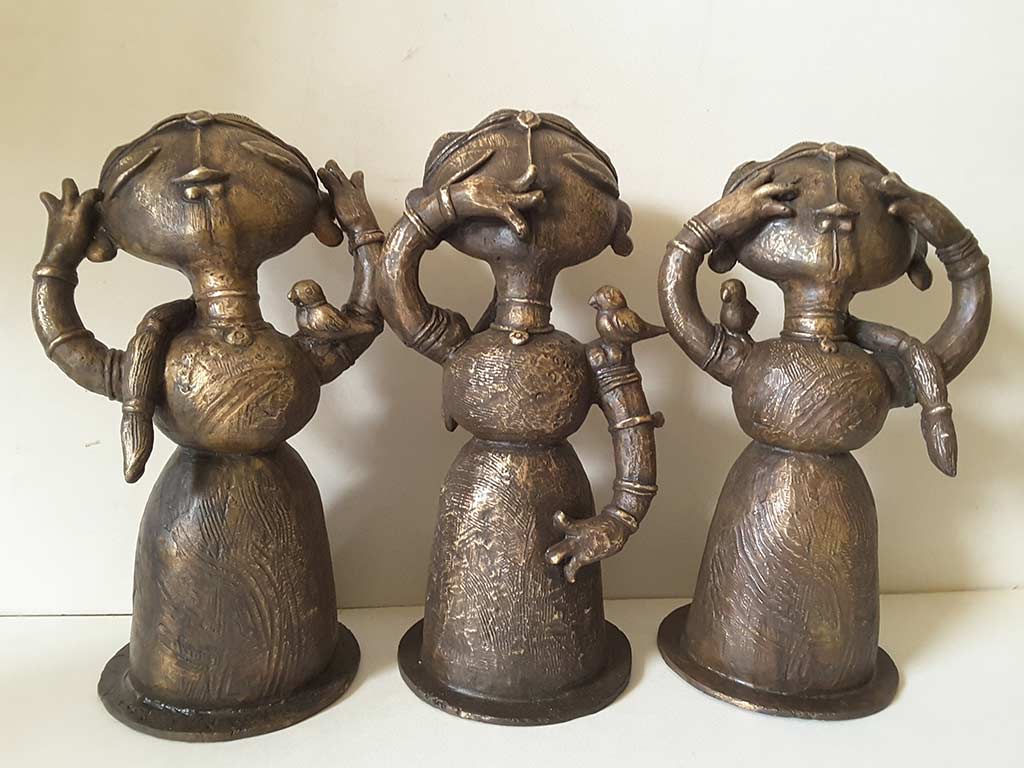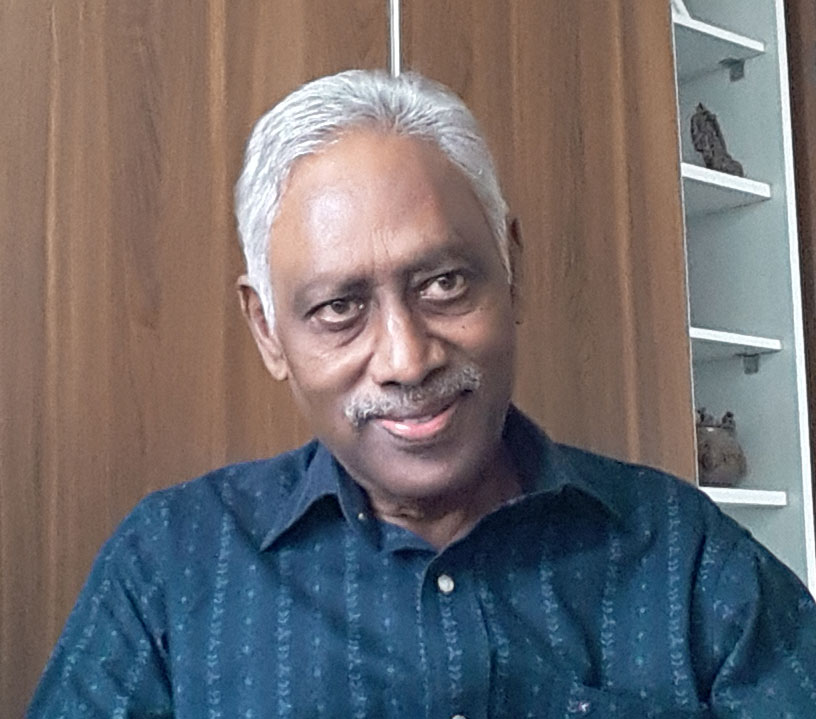Return to Innocence
Artist Subramanian Gopalsamy talks to us about his art, his practice, his inspirations and the journey wherein lies the beauty of it all
Vani Sriranganayaki
When looking for an artist to create the cover of our issue on the ‘Other Side’, we cast the net far and wide. We were looking for artists who went against the grain, trudged there, where no one’s ever been and found new meanings that redefined the norm. We realised soon enough that we were looking for a needle in a haystack – only it wasn’t a haystack, but a stack of needles. And just as we were about to give up on the quest, we came across artist Subramanian Gopalsamy’s collages, which often depict chubby gods and little girls with large hooded eyes and bright red lips smiling up at you. Sure enough, the colours, the intricate details and the expertise with which they were brought together caught our attention; but what kept it there was the unique approach, especially his recent shift to bronze sculptures that rendered his collages a whole new dimension. His idea for the cover: a chubby, shiny sculpture of Krishna. Like so many before us, we too, misguidedly, viewed religion and tradition as one of two things – something that needs safe-guarding or something that obstructs progress – and were a little hesitant. But Subra (as he is lovingly known) put forth a narrative that celebrated the stories and the child-like innocence and wonder that are invariably tied to them. ‘I never wanted to take it as a serious issue. I am from Thandavankulam, a coastal village in Nagapattinam district. My father was a theatre artiste who performed folk plays. So, this was the theme of my childhood, normal people become mythological characters when they put on makeup. I was brought up around temples, rituals and stories. As a kid, and even after growing up, I never questioned them. It’s become a part of life. And, it is beautiful,’ he said.

Never one to begrudge others their greener pastures, Subra found contentment in a practice that unfailingly brings smiles to our faces. In his own honest and charming way, he showed us that the journey to the ‘Other Side’ wasn’t a sudden drop down a rabbit hole or an explosive realisation. It could very easily be embedded in the everyday, among the thrill of possibilities or the warmth of acceptance. And to him, the polarising concepts of religion or tradition represent just that. ‘We enjoy all festivals, regardless of the religion. Eighteen years in Saudi Arabia, every Ramadan was a great experience. In my apartment block, a maulvi lived downstairs. I would wake up early in the morning to work on my Innerlines series to the sounds of the maulvi’s morning prayer cassette. It is such a beautiful sound… When I won the Saudia Malwan Award, the prize was a trip to European destinations, I got to visit Rome and Paris and all those places. When I was standing under Michelangelo’s work at the Sistine Chapel, I remember being aware that an Islamic country had given an award to a Hindu who was standing in the Sistine Chapel. I remember thinking then that they are all the same – beautiful’, he said over a telephonic conversation where he took us through his own journey in art – the pits and falls and the rise into, well, beauty.

Excerpts from the interview
You have said before that loss often leads to new beginnings; and your own journey, after the tragic loss of your daughter stands testament to the fact. It could not have been an easy journey. Can you let us in on that experience, back when you first found meaning and purpose in art?
This is something very close to my heart. I was never a serious painter, especially when I first started. Soon after we moved to Saudi Arabia, my daughter was diagnosed with bone cancer. In the immediate aftermath of her death, when we went back to Saudi Arabia, our close friends tried their best to help us cope. Every Friday, they would ask me to teach art to their kids. Initially, I was at a loss, but soon I started looking forward to it. And the kids were mostly girls of my daughter’s age; probably girls are more interested in art. I don’t know… In watching them work, I learnt so many things, how to simplify drawings, colour with ease. It took me so many years to draw like a 9-year-old!
I also like listening to Ramana Maharshi. At that time, I started doing some spiritual work around the Innerlines series – it was all about nature and being connected in a sense. So that was the process, the principle, I was working with. When we came back to India, we were still dealing with the loss, and that is when I started the She series. Whatever I do, she, my daughter, is always in front of me. She becomes a meditating girl, or a singer with a tambura, or I imagine her friends. Then I found that these collages were well received, so I kept doing it. In a way, through my art, I am living with my daughter.

Your collages breathe new life into old magazine papers. Everything about them, from the choice of paper, and colours to the details and expression, is enchanting. When you first started making collages all those years ago, what was your intent?
I first started making collages in my college days. But then I didn’t until I went to Saudi. When I came back to India, when I wanted to start professionally, I was not making collages. I had started the She series on acrylic. When my son suggested that I go back to collages, my first thought was that I can’t make money doing collages. But then I remembered the collages by Satish Gujral, Picasso and Matisse, and that inspired me. The first collage work I sold, a Guitar Girl, was to a family friend for just Rs. 6,000. I didn’t quote the price, just told her to give whatever she wanted. Then it was more about acceptance, about encouragement. It gave me the confidence to start, and it’s become a never-ending story now!

The lines, the motifs and details in your works make them instantly recognisable. But they are still vastly different from each other. Can you tell us about your approach?
Actually, the medium itself has a lot of plus points for me. Texture, detail, design, everything is technically printed. A photograph of the sky or a blue underwater shot – that becomes my face, or you know Krishna’s face. So, the photographs from the magazines do more than 50% of my job. I use only National Geographic as they carry more creative photographs. any subject they tackle, they go very deep into that. There is so much information in there. Sometimes, I stop working and start reading! So, it is a continuous process…

Devoid of colours or the added abstraction of a background, your sculptures lend a completely different aesthetic experience. What prompted this shift in mediums?
Actually, the inspiration is from the terracotta horses from the Ayyanar temple in my village. Even when I started, in my first year in college, I only made terracotta horses. Sculpture, to me, is a very interesting subject and has been for a long time. It has always been on my mind. In 2018, artist Gnana suggested that my She series would look really nice as bronze sculptures. And he recommended this traditional artisan family from Swamimalai who have been living there since the Chola period. So, we went there and we started working first with clay. When I saw the three-dimensional girls without any background in a metal form, it was so exciting. To me, the girls are still the same – in the most simplified way. But it is a very exciting experience to do both.

As you traverse between mediums, what is the most important lesson you have learnt?
There is nothing that is easy or difficult. Everything is tough. In everything you have to think. In everything you have to create. It has its own importance. We have to visualise it all in the mind. At night, when I am thinking about it, I can see the painting, I can be the work. I imagine how it looks and what I can do. But ultimately, it has to satisfy me. All the mediums that I explored were challenging in their own right. But I still enjoy it. It is a process. That is why they call art a ‘practice’ – it is never-ending. It is never a completed work. It is only a process that you are continuously trying to perfect.

________________________________________________________________________
All Images Courtesy of the Artist.
Share